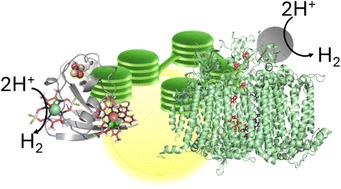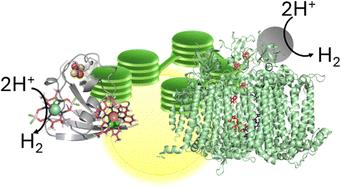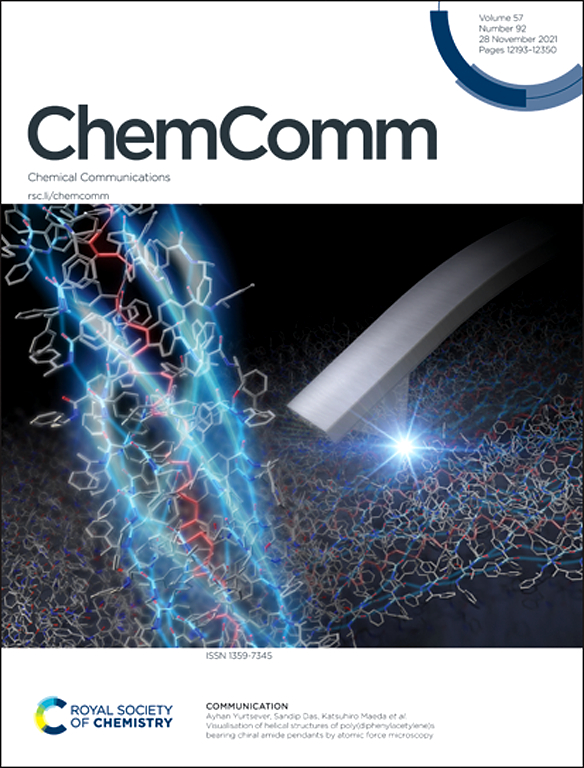用于太阳能燃料催化的光合生物杂交系统。
IF 4.3
2区 化学
Q2 CHEMISTRY, MULTIDISCIPLINARY
引用次数: 0
摘要
光合作用反应中心(RC)蛋白质是经过精细调整的分子系统,可优化太阳能转换。RC 利用光诱导的定向电子转移,通过嵌入蛋白质核心的一系列分子辅助因子,有效地捕获和转换太阳光,其量子效率接近统一,从而产生具有可用电化学势的长寿命电荷分离状态。目前令人感兴趣的是将 RC 化学与直接合成富含能量的化合物相结合的新策略。这篇特写文章重点介绍了我们实验室在 RC 和受 RC 启发的混合系统方面的最新研究成果,这些系统可以捕获太阳能量并将其转化为 H2 形式的化学能,H2 是一种碳中和能源,来源于水。由光子系统 I(PSI)RC 制成的生物混合物是迄今为止最好的光催化产生 H2 的蛋白质混合物之一。将非生物催化剂与 PSI 相结合的定向自组装策略可将催化剂结合到类囊体膜内 PSI 的固有位点,从而实现完整的太阳能水分离系统。受遥控启发的生物混合物将合成光敏剂和分子催化剂与小蛋白质结合在一起,形成光催化系统,并能从光谱学角度识别支撑太阳能驱动的质子还原的结构特征和电子传递过程。总之,这些研究展示了光合生物杂交研究为利用人工和天然光合系统的最佳品质以及开发可捕获、转换和储存太阳能作为燃料的材料提供的令人难以置信的科学机遇。本文章由计算机程序翻译,如有差异,请以英文原文为准。


Photosynthetic biohybrid systems for solar fuels catalysis
Photosynthetic reaction center (RC) proteins are finely tuned molecular systems optimized for solar energy conversion. RCs effectively capture and convert sunlight with near unity quantum efficiency utilizing light-induced directional electron transfer through a series of molecular cofactors embedded within the protein core to generate a long-lived charge separated state with a useable electrochemical potential. Of current interest are new strategies that couple RC chemistry to the direct synthesis of energy-rich compounds. This Feature Article highlights recent work from our lab on RC and RC-inspired hybrid systems that capture the Sun's energy and convert it to chemical energy in the form of H2, a carbon-neutral energy source derived from water. Biohybrids made from the Photosystem I (PSI) RC are among the best photocatalytic H2-producing protein hybrids to date. Targeted self-assembly strategies that couple abiotic catalysts to PSI translate to catalyst incorporation at intrinsic PSI sites within thylakoid membranes to achieve complete solar water-splitting systems. RC-inspired biohybrids interface synthetic photosensitizers and molecular catalysts with small proteins to create photocatalytic systems and enable the spectroscopic discernment of the structural features and electron transfer processes that underpin solar-driven proton reduction. In total, these studies showcase the incredible scientific opportunities photosynthetic biohybrid research provides for harnessing the optimal qualities of both artificial and natural photosynthetic systems and developing materials that capture, convert, and store solar energy as a fuel.
求助全文
通过发布文献求助,成功后即可免费获取论文全文。
去求助
来源期刊

Chemical Communications
化学-化学综合
CiteScore
8.60
自引率
4.10%
发文量
2705
审稿时长
1.4 months
期刊介绍:
ChemComm (Chemical Communications) is renowned as the fastest publisher of articles providing information on new avenues of research, drawn from all the world''s major areas of chemical research.
 求助内容:
求助内容: 应助结果提醒方式:
应助结果提醒方式:


